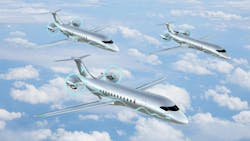Embraer eyes electric future with Energia aircraft concepts
SÃO JOSÉ DOS CAMPOS, Brazil - Aircraft manufacturer Embraer in São José dos Campos, Brazil announced advancements in its Energia sustainable aircraft project, broadening its research focus from 30-seat to 50-seat aircraft. The company also revealed it is now exploring hydrogen gas turbine/dual fuel (GT/DF) technologies, in addition to its existing research into hybrid electric and fuel cell propulsion systems.
These developments stem from insights provided by Embraer’s Energia Advisory Group, which includes airlines, lessors, suppliers, and other aviation experts. The group advises Embraer on sustainable aircraft development, focusing on propulsion technologies, aerodynamics, structural design, systems integration, and passenger comfort. The goal is to create sustainable and commercially viable aircraft for the future.
Arjan Meijer, President & CEO of Embraer Commercial Aviation, highlighted the company's commitment to evolving with technological, infrastructural, and regulatory changes. “We will continue to explore the needs of our customers’ and the industry as technology potentials, infrastructure, and regulation evolve – we foresee a potential entry into service of an Energia concept in the next decade. I would like to thank the members of the advisory group for so generously giving their time and expertise to this important challenge," Meijer said. He emphasized the importance of ensuring complete feasibility across technical, economic, commercial, and infrastructure aspects.
Related: Embraer and Brazilian government sign agreement to develop new aerospace tech
The updated Energia concepts include advanced airframe designs, improved aerodynamics, enhanced cabin comfort, and reduced noise levels, thanks to rear propulsion configurations.
For Hybrid-Electric concepts, Embraer is developing a parallel hybrid electric powerplant, integrating next-generation thermal engines with small electric motors to improve efficiency during takeoff and idle phases. The propulsion system is paired with more electric aircraft systems and a small, cost-efficient battery.
The Fuel Cell concept features a propulsion system that promises zero carbon, NOx, and soot emissions. While more efficient than small gas turbines, it is heavier and requires complex thermal management. Embraer is working on optimizing fuel cell thermal management to reduce weight and drag.
The Hydrogen/Dual Fuel concept involves a gas turbine engine that can run on hydrogen or dual fuel. In the dual fuel setup, hydrogen is used for typical missions, with JetA/SAF reserved for range extension and reserves. The hydrogen-only option is designed for zero carbon emissions and low NOx output.
About the Author
Jamie Whitney
Senior Editor
Jamie Whitney joined the staff of Military & Aerospace Electronics in 2018 and oversees editorial content and produces news and features for Military & Aerospace Electronics, attends industry events, produces Webcasts, and oversees print production of Military & Aerospace Electronics.
